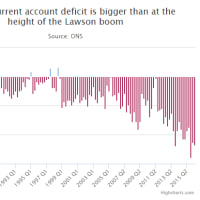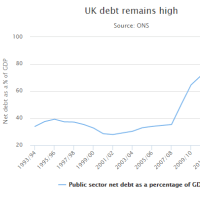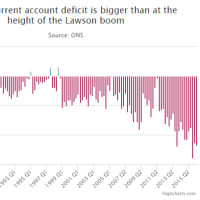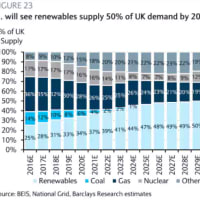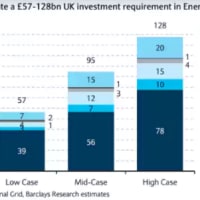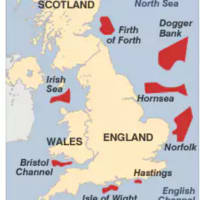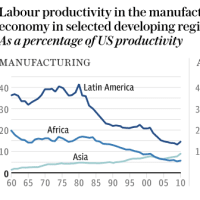Money markets:The big thaw
(金融市場:大きな雪解け)
Economist.com:Oct 22nd 2008
Frozen credit markets are coming back to life
フリーズしていた信用市場が息を吹き返しつつある。
THE world’s banking system may still be in intensive care, kept alive largely with the help of generous infusions of capital, liquidity and guarantees on lending from governments. Yet there are hopeful―albeit tentative―signs of recovery.
資本と流動性と信用保証を政府にたっぷり投与されて生かされている世界の銀行システムは、未だICUを出られないかもしれない。
だが希望の光は、まあ確かに一時的ではあるが、回復の兆しは見えている。
An important indicator of its health is the price that banks say they expect to pay to borrow money for three months, which is usually expressed as the London Interbank Offered Rate (LIBOR), or its European equivalent, EURIBOR. These have been ticking down slowly, often by only fractions of a percentage point a day. Yet on Tuesday October 21st the rate for borrowing euros passed an important milestone, falling to 4.96%, a level last seen before Lehman Brothers collapsed in mid-September. The LIBOR spread over three-month American Treasury bills has also narrowed sharply. The recent improvements were partly stirred by the latest lavish intervention from the Federal Reserve. It made available $540 billion to buy assets from money-market funds, to encourage them to start buying commercial paper issued by banks and companies again.
銀行がお互いに3ヶ月間金を貸し借りする時にくっつける金利、というのは銀行システムの健全性を示す重要な指標で、世間様ではLIBOR(ヨーロッパならEURIBOR)として知られております。
これがちょっとずつゆっくりと、一日に何度も1%の何分の一かをちまちまちまちま、下ってきている。
そして10月21日には、ユーロの借入金利が4.96%という重要な一里塚を突破した。
何で重要かというと、これこそ9月の半ばにリーマン・ブラザーズが破綻する前の水準だから。
で、そのLIBORと3ヶ月物米国債のスプレッドも、急速に縮まってきた。
ここに来て良くなってきたのは、最近FRBがガンガン介入して引っ掻き回してくれたせいもある。
銀行や企業が出した債券を買い始めろよ、と励ますために、MMFから資産を買い取りましょうと$5,400億も出したんだから。
The pace of LIBOR’s recovery may look glacial, but it is actually faster than meets the eye. This is because LIBOR, the heart-rate monitor of the financial markets, seems to have gone on the blink. When markets were at their most stressed it underestimated the full cost to banks of borrowing―partly, in its defence, because there was so little lending in the interbank markets. The rates now being paid by banks to borrow may actually be half the level during the most intense moments of panic earlier this month.
LIBORの改善スピードはノロノロとして見えるかもしれないけど、実際は目で見てるよりも早いわけで。
というのも、LIBORって金融市場の心拍計は、おかしくなってたらしいからでね。
市場が一番きつかった時は、銀行の借入コストを過小評価していた。
自己防衛で銀行間貸付市場での貸し借りが余りにも少なかった、ってこともあったからだけど。
今や銀行が金を借りるために払っている金利は、今月先にパニックが一番激しかった時期の金利の半分になった。
More importantly, money is once again starting to flow through the system. メCompared with three weeks ago borrowing volumes are up by as much as ten times,モ says Tim Bond of Barclays Capital. The trouble, however, is that the banks still need a lifeline from central banks, which have opened the floodgates of dollars and euros. The European Central Bank, for instance, has loaned ロ773 billion ($1 trillion) to banks.
もっと重要なことは、お金が再びシステムを流れ始めたってことだ。
「3週間前と比べれば、借入は最大で10倍にもなった」とはバークレーズ・キャピタルのティム・ボンド。
でも問題は、銀行が相変わらず、ドルとユーロの水門を開いた中央銀行からのライフラインを、必要としていることだね。
例えばECBなんて、EUR7,730億も銀行に貸してるんだよ。
The best indicator of a healthy financial system would be banks once again lending money to one another. There is improvement here, too. American banks including JPMorgan Chase and Citigroup have, in the past week, made loans to European counterparts for up to three months. And HSBC, Europe’s biggest bank, says it is providing billions in three- and six-month funding to banks.
金融システムの健康状態が一番よくわかる指標は、やっぱり銀行間の貸付だろうね。
その状況もマシになっている。
JPモルガン・チェースやシティグループを含むアメリカの銀行は、この一週間、ヨーロッパの銀行に最長3ヶ月間の融資を行ったし。
ヨーロッパ最大の銀行HSBCは、数十億も3ヶ月物ローンや6ヶ月ものローンを銀行に貸し付けている、と言っているよ。
Markets for longer-term credits for banks are also gradually returning to life as institutional investors regain their nerve. On October 17th Lloyds TSB managed to sell 」400m ($690m) worth of ten-year bondsムthe first such issue by a European bank since the collapse of Lehman. As of Wednesday Barclays was planning to borrow ロ3 billion over three years by issuing notes backed by the government. But the cost of borrowing remains uncomfortably high. Lloyds TSB, for instance, paid 2.25 percentage points above the interest rate on an equivalent government bonds. Barclays, which will be charged about 1.5 percentage points by the government for the guarantee of its bonds, may end up paying almost as much as Lloyds for its borrowing.
もうちょっと長期の銀行向信用のための市場も、機関投資家が落ち着きを取り戻すに連れ、徐々に息を吹き返しつつある。
10月17日、ロイズTSBはなんと£4億($6.9億)相当物10年債を売りつけるのに成功した…ヨーロッパの銀行がこんなことをやったのは、リーマン・ブラザーズ破綻から初めてだ。
水曜日にはバークレーズが、政府支援債券を発行して、3年間の期限でEUR30億の借入を計画していた。
でもまあ、借入コストは相変わらず高過ぎるけどね。
例えばロイズTSBなんて、国債の金利に2.25%も乗せなきゃいけなかったし。
政府に大体1.5%の債券保証料を取られることになるバークレーズも、ロイズと同じ位払うことになるかもね。
Meanwhile, banks are exposed to further possible write-downs which could strain money markets once more. More businesses are going bust, which will put further pressure on the vast credit-derivative markets. Consumer loans are souring. If another big bank were to come close to failing, the financial system might yet be back on life support.
その一方で、銀行は更なる評価損に見舞われるかもしれないし、これはまた金融市場に負担をかけるだろう。
更に多くの企業が破綻すれば、これも巨大なクレジット・デリバティブ・マーケットに追加圧力をかけるだろう。
消費者金融の貸付額は急激に増加している。
もう一つ大手銀行が破綻しかければ、金融システムは再びICU入りかもしれない。
 | KGBの世界都市ガイド晶文社このアイテムの詳細を見る |










